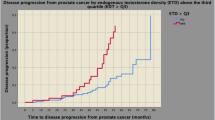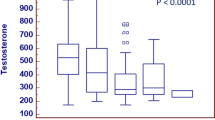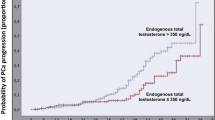Abstract
Objective
To evaluate the association between basal total testosterone (TT) levels with the European Association of Urology (EAU) risk classes at the time of diagnosis of prostate cancer (PCA).
Methods
A retrospective review of prospectively collected data was carried out between November 2014 and March 2018. Preoperative basal TT levels and PSA were measured in 601 consecutive Caucasian patients who were not under androgen deprivation and undergoing surgery at a tertiary referral center. Patients were classified into low (reference group), intermediate- and high-risk/locally advanced classes. The multinomial logistic regression model evaluated associations of TT and other clinical factors with EAU risk classes.
Results
One hundred twenty four patients (24%) were low risk, 316 (52.6%) were intermediate, 199 (16.5%) were high risk and 42 (7%) were locally advanced. Median circulating basal TT levels increased along EAU classes. TT, PSA, percentage of biopsy-positive cores and tumor clinical stage were independently associated with the high-risk class (odds ratio, OR = 1.002; p = 0.030) but were not associated with intermediate-risk or locally advanced PCA when compared to the low-risk class. TT above the median value was an independent predictor of high-risk class PCA.
Conclusions
Basal TT levels are positively associated with low, intermediate and high EAU risk classes. The association is significant for the high-risk class when compared to the low-risk group, but was lost in locally advanced risk class. In PCA patients, high TT serum levels are associated with high-risk disease. Endogenous TT should be considered as a biological marker for assessing EAU PCA risk classes.

Similar content being viewed by others
References
Huggins C, Hodges CV (1972) Studies on prostatic cancer. I. The effect of castration, of estrogen and androgen injection on serum phosphatases in metastatic carcinoma of the prostate. CA Cancer J Clin. 22(4):232–240
Wu FC, Tajar A, Pye SR, Silman AJ, Finn JD, O'Neill TW et al (2008) Hypothalamic-pituitary-testicular axis disruptions in older men are differentially linked to age and modifiable risk factors: the European Male Aging Study. J Clin Endocrinol Metab 93(7):2737–2745
Porcaro AB, de Luyk N, Corsi P, Sebben M, Tafuri A, Tamanini I et al (2017) Bilateral lymph node micrometastases and seminal vesicle invasion associated with same clinical predictors in localized prostate cancer. Tumori J 103(3):299–306
Porcaro AB, De Luyk N, Corsi P, Sebben M, Tafuri A, Processali T et al (2017) Association between basal total testosterone levels and tumor upgrading in low and intermediate risk prostate cancer. Urol Int 99(2):215–221
Porcaro AB, Petroziello A, Brunelli M, De Luyk N, Cacciamani G, Corsi P et al (2016) High testosterone preoperative plasma levels independently predict biopsy gleason score upgrading in men with prostate cancer undergoing radical prostatectomy. Urol Int 96(4):470–478
Salonia A, Gallina A, Briganti A, Abdollah F, Suardi N, Capitanio U et al (2011) Preoperative hypogonadism is not an independent predictor of high-risk disease in patients undergoing radical prostatectomy. Cancer 117(17):3953–3962
Porcaro AB, Tafuri A, Sebben M, Corsi P, Pocessali T, Pirozzi M et al (2018) Positive association between preoperative total testosterone levels and risk of positive surgical margins by prostate cancer: results in 476 consecutive patients treated only by radical prostatectomy. Urol Int 101(1):38–46
Massengill JC, Sun L, Moul JW, Wu H, McLeod DG, Amling C et al (2003) Pretreatment total testosterone level predicts pathological stage in patients with localized prostate cancer treated with radical prostatectomy. J Urol 169(5):1670–1675
Dai B, Qu Y, Kong Y, Ye D, Yao X, Zhang S et al (2012) Low pretreatment serum total testosterone is associated with a high incidence of Gleason score 8–10 disease in prostatectomy specimens: data from ethnic Chinese patients with localized prostate cancer. BJU Int 110(11 Pt B):E667–E672
Ferro M, Lucarelli G, Bruzzese D, Di Lorenzo G, Perdona S, Autorino R et al (2017) Low serum total testosterone level as a predictor of upstaging and upgrading in low-risk prostate cancer patients meeting the inclusion criteria for active surveillance. Oncotarget 8(11):18424–18434
Mottet N, Bellmunt J, Bolla M, Briers E, Cumberbatch MG, De Santis M et al (2017) EAU-ESTRO-SIOG guidelines on prostate cancer. Part 1: screening, diagnosis, and local treatment with curative intent. Eur Urol 71(4):618–629
Epstein JI, Egevad L, Amin MB, Delahunt B, Srigley JR, Humphrey PA (2016) The 2014 international society of urological pathology (ISUP) consensus conference on gleason grading of prostatic carcinoma: definition of grading patterns and proposal for a new grading system. Am J Surg Pathol. 40(2):244–252
Porcaro AB, Tafuri A, Sebben M, Novella G, Processali T, Pirozzi M et al (2019) Prostate volume index and prostatic chronic inflammation predicted low tumor load in 945 patients at baseline prostate biopsy. World J Urol. https://doi.org/10.1007/s00345-019-02830-7
Walsh PC (1998) Anatomic radical prostatectomy: evolution of the surgical technique. J Urol 160(6 Pt 2):2418–2424
Porcaro AB, Cacciamani GE, Sebben M, Tafuri A, Processali T, Rizzetto R et al (2019) Lymph nodes invasion of marcille's fossa associates with high metastatic load in prostate cancer patients undergoing extended pelvic lymph node dissection: the role of “marcillectomy”. Urol Int 103(1):25–32. https://doi.org/10.1159/000500330
Cacciamani GE, Porcaro AB, Sebben M, Tafuri A, Rizzetto R, De Luyk N et al (2019) Extended pelvic lymphadenectomy for prostate cancer: should the cloquet's nodes dissection be considered only an option? Minerva Urol Nefrol 71(2):136–145
Briganti A, Larcher A, Abdollah F, Capitanio U, Gallina A, Suardi N et al (2012) Updated nomogram predicting lymph node invasion in patients with prostate cancer undergoing extended pelvic lymph node dissection: the essential importance of percentage of positive cores. Eur Urol 61(3):480–487
Porcaro A, Inverardi D, Corsi P, Sebben M, Cacciamani G, Tafuri A et al (2018) Prostate specific antigen levels and proportion of biopsy positive cores are independent predictors of upgrading patterns in low risk prostate cancer. Minerva urologica e nefrologica Ital J Urol Nephrol. https://doi.org/10.23736/S0393-2249.18.03172-7
Porcaro AB, Siracusano S, Luyk Nd, Corsi P, Sebben M, Tafuri A et al (2018) Clinical factors stratifying the risk of tumor upgrading to high-grade disease in low-risk prostate cancer. Tumori J. 104(2):111–115
Porcaro AB, Tafuri A, Sebben M, Processali T, Pirozzi M, Shakir A et al (2019) Total testosterone density predicts high tumor load and disease reclassification of prostate cancer: results in 144 low-risk patients who underwent radical prostatectomy. Int Urol Nephrol 51(12):2169–2180
Klap J, Schmid M, Loughlin KR (2015) The relationship between total testosterone levels and prostate cancer: a review of the continuing controversy. J Urol 193(2):403–413
Lopez DS, Advani S, Tsilidis KK, Wang R, Canfield S (2017) Endogenous and exogenous testosterone and prostate cancer: decreased-, increased- or null-risk? Transl Androl Urol 6(3):566–579
Zagars GK, Pollack A, von Eschenbach AC (1997) Serum testosterone—a significant determinant of metastatic relapse for irradiated localized prostate cancer. Urology 49(3):327–334
Imamoto T, Suzuki H, Akakura K, Komiya A, Nakamachi H, Ichikawa T et al (2001) Pretreatment serum level of testosterone as a prognostic factor in Japanese men with hormonally treated stage D2 prostate cancer. Endocr J 48(5):573–578
Porcaro AB, De Luyk N, Corsi P, Sebben M, Tafuri A, Cacciamani G et al (2017) Preoperative plasma levels of total testosterone associated with high grade pathology-detected prostate cancer: preliminary results of a prospective study in a contemporary cohort of patients. Curr Urol 10(2):72–80
Porcaro AB, Tafuri A, Sebben M, Pirozzi M, Processali T, Rizzetto R et al (2019) Positive association between basal total testosterone circulating levels and tumor grade groups at the time of diagnosis of prostate cancer. Urol Int 103(4):400–407. https://doi.org/10.1159/000500960
Park J, Cho SY, Jeong SH, Lee SB, Son H, Jeong H (2016) Low testosterone level is an independent risk factor for high-grade prostate cancer detection at biopsy. BJU Int 118(2):230–235
Wang K, Chen X, Bird VY, Gerke TA, Manini TM, Prosperi M (2017) Association between age-related reductions in testosterone and risk of prostate cancer—An analysis of patients' data with prostatic diseases. Int J Cancer 141(9):1783–1793
Morgentaler A, Traish AM (2009) Shifting the paradigm of testosterone and prostate cancer: the saturation model and the limits of androgen-dependent growth. Eur Urol 55(2):310–320
Fujita K, Nonomura N (2019) Role of androgen receptor in prostate cancer: a review. World J Mens Health 37(3):288–295. https://doi.org/10.5534/wjmh.180040
Paris PL, Hofer MD, Albo G, Kuefer R, Gschwend JE, Hautmann RE et al (2006) Genomic profiling of hormone-naive lymph node metastases in patients with prostate cancer. Neoplasia 8(12):1083–1089
Shoag J, Barbieri CE (2016) Clinical variability and molecular heterogeneity in prostate cancer. Asian J Androl 18(4):543
Porcaro AB, Tafuri A, Sebben M, Cacciamani G, Ghimenton C, Brunelli M et al (2019) Low preoperative prolactin levels predict non-organ confined prostate cancer in clinically localized disease. Urol Int 103(4):391–399. https://doi.org/10.1159/000496833
Salonia A, Abdollah F, Capitanio U, Suardi N, Briganti A, Gallina A et al (2012) Serum sex steroids depict a nonlinear u-shaped association with high-risk prostate cancer at radical prostatectomy. Clin Cancer Res 18(13):3648–3657
Porcaro A, Tafuri A, Sebben M, Processali T, Pirozzi M, Amigoni N et al (2019) Body mass index and prostatic specific antigen are independent predictors of multiple prostate cancer lymph node metastases in Caucasian patients undergoing robot assisted radical prostatectomy and extended pelvic lymph node dissection. Minerva urologica e nefrologica Ital J Urol Nephrol 71(5):516–523
Porcaro AB, Tafuri A, Sebben M, Processali T, Pirozzi M, Amigoni N et al (2019) High body mass index predicts multiple prostate cancer lymph node metastases after radical prostatectomy and extended pelvic lymph node dissection. Asian J Androl. https://doi.org/10.4103/aja.aja_70_19
Porcaro AB, Sebben M, Tafuri A, de Luyk N, Corsi P, Processali T et al (2019) Body mass index is an independent predictor of Clavien-Dindo grade 3 complications in patients undergoing robot assisted radical prostatectomy with extensive pelvic lymph node dissection. J Robot Surg 13(1):83–89
Feldman HA, Longcope C, Derby CA, Johannes CB, Araujo AB, Coviello AD et al (2002) Age trends in the level of serum testosterone and other hormones in middle-aged men: longitudinal results from the Massachusetts male aging study. J Clin Endocrinol Metab 87(2):589–598
Goldman AL, Bhasin S, Wu FCW, Krishna M, Matsumoto AM, Jasuja R (2017) A reappraisal of testosterone's binding in circulation: physiological and clinical implications. Endocr Rev 38(4):302–324
Rosner W, Vesper H, E.S.t.e. Organizations (2010) Toward excellence in testosterone testing: a consensus statement. J Clin Endocrinol Metab 95(10):4542–4548
Funding
The authors did not receive financial support.
Author information
Authors and Affiliations
Contributions
A Tafuri: project development, data collection, data analysis and interpretation, manuscript writing. M Sebben: data collection, data interpretation, manuscript writing. AB Porcaro: project development, data analysis and interpretation, manuscript writing. A Shakir: manuscript writing and language and critical revision. M Pirozzi, T Processali, N Amigoni, R Rizzetto: data collection. M Brunelli, F Migliorini, MA Cerruto, S Siracusano, A. Antonelli, W Artibani: other (supervision and critical revision).
Corresponding author
Ethics declarations
Conflict of interest
The authors declare that they have no conflict of interest.
Ethical approval
All procedures performed in studies involving human participants were in accordance with the ethical standards of the institutional and/or national research committee and with the 1964 Helsinki Declaration and its later amendments or comparable ethical standards.
Informed consent
Informed consent was obtained from all individual participants included in the study.
Additional information
Publisher's Note
Springer Nature remains neutral with regard to jurisdictional claims in published maps and institutional affiliations.
Rights and permissions
About this article
Cite this article
Tafuri, A., Sebben, M., Shakir, A. et al. Endogenous testosterone mirrors prostate cancer aggressiveness: correlation between basal testosterone serum levels and prostate cancer European Urology Association clinical risk classes in a large cohort of Caucasian patients. Int Urol Nephrol 52, 1261–1269 (2020). https://doi.org/10.1007/s11255-020-02398-x
Received:
Accepted:
Published:
Issue Date:
DOI: https://doi.org/10.1007/s11255-020-02398-x




